Sep 13, 2012
The Truth Behind the Shrinking Arctic Ice Cap
By Joe Bastardi, Weatherbell
There is no sugar coating the fact that the Arctic sea ice is well below normal.
The AGW agenda is jumping all over this metric as evidence that catastrophic global warming is upon us. After all, they really can no longer use earth’s actual air and ocean temperatures as proof since they have leveled off, and are now cooling. The disconnect with C02, still on the rise, cannot be denied.
As you can see, I admit Arctic sea ice is on the decline, but the question is, why?
The answer can be seen through natural causes. A look at the ocean temperatures globally over the past 15 years, or since the global temperatures reached a peak in the major el Nino of 1997-1998 supplies the answer. Notice on Sept 1, 1997, most of the northern hemisphere ocean was quite warm, the southern hemisphere cooler. This is an example of the warm phases of the Pacific Decadol Oscillation and the Atlantic Multidecadol Oscillation both occurring at once. A tremendous input of heat (oceans have 1000 times the heat capacity of air) into the atmosphere has to be occurring, causing a rise in the global temperature which was well documented through the 1990s.
But one also notices a counter cooling in much of the southern hemisphere oceans.
Since dry air over land warms more than air over the ocean, the response of the warming ocean when that air came over the drier land was more of a rise in temperatures over the continents than fall over the southern hemisphere oceans . So it appears that the earth is warming. After all if you have many more samples of warm than cold, your answer has to come up warmer, right? However, is there a change in the total energy budget of the earth? If there is not then what goes up, must come down. The earths temperature rose in response to the warming Pacific, which started the northern ice cap melting. The Atlantic is in its warm stage now, so the ice cap is being attacked from the ocean also. Once the Atlantic comes out of its warm phase in 10 to 15 years, the ice cap will rebound.
Below are charts in 5 year increments that show a reversal has occurred in the Pacific:
2002
2007
2012 at the height of the La Nina
The current water temperature anomaly shows very warm water in the north Atlantic, a product of the warm cycle of the Atlantic we are in like the 1950s, and this continues to attack the ice cap.
But is the lack of ice at times that unusual? Apparently not as photographic evidence shows. Here is a picture of a submarine surfacing at the North Pole in August of 1959—another period of known warmth similar to the cycle we are in now.
More startling to me was this picture that shows large amounts of open water at the North Pole in May of 1987 with three subs surfacing.
Wind and storminess can also have an effect on the Arctic ice, which is what recently happened. A fierce storm broke up a lot of the ice and shoved much of it southeast into the center of the ice cap. But when viewing this 30 day loop of the arctic, notice how fast the rebound from the low point has been in the past 30 days, with a shrinkage because of the storm, then the ice rapidly rebounding (make sure to put this into a loop).
The recent pronouncement that Greenland had the most rapid melt period on record is another example of neglecting the actual facts to come up with an objective idea. If you would like to read more on that matter, here is a nice link.
The reason we are seeing all this is because we have seen a distortion of the global temperature pattern the past 30 years brought about by the warm phase of the Pacific, which started the warming of the northern hemisphere, followed by the Atlantic warming. The response was greater over land where air is dry and can be easily warmed! How can we test this theory, besides waiting for it to simply recover once the Atlantic turns colder? Well we have a hint, and it’s in the southern hemisphere. After all, we have to think globally, right? That is what we hear: GLOBAL warming. So we should also have the southern hemisphere shrinking if they are correct and my hypothesis is wrong.
Let’s evaluate, shall we?
Over the past 30 years there has been a rise in the southern ice cap! One would never know it given all the hysteria about the northern ice cap, or some spots on Antarctica being warmer than normal ( it can’t be cold everywhere).
I spoke on this matter at the Heartland conference ICCC7. Because the southern hemisphere ice cap is surrounded by ocean, the implication of an expanding southern hemisphere ice cap, even though it appears smaller than the northern shrinkage, is that there is no net change in the overall heat capacity of the entire ocean/air system. This would imply the northern shrinkage is simply a cyclical event. In fact, the increase in the south is actually quite remarkable since it takes more energy loss to cool the water enough around the southern hemisphere ice cap than it does energy gain to warm the dry, colder air over land surrounding the northern hemisphere ice cap The warming of that air, combined with the warm cycle still present in the Atlantic means there should be a shrinking northern ice cap. This is yet another challenge I have laid at the feet of the AGW community: The idea that the global temperature as measured objectively by satellites will return to where it was in the late 1970s by 2030 and the northern ice cap will also. Truth be told, we will be in real trouble if there is no warming response to the oceans in the southern hemisphere and shrinking back of that ice cap! That is more of a concern to many of us than the idea the planet is about to burn up. It’s ice, not fire that should be the concern, especially when one looks at some of the ideas on the solar cycles and temperatures, as well as the economic and social repercussions of a colder planet. For your benefit, here’s a recent paper on the matter of sunspots and global temperatures.
As a nation, we must use what has made us successful to progress. The limiting of energy sources based on faulty ideas and partial truths has lead to a weakening of our country and increased misery among our people. For example: Gas is nearly 4 dollars a gallon now, and the shame is that there is no reason based on what we should be doing, for that to be happening. This is taking hundreds of billions of dollars out of our economy and redistributing it elsewhere. Regulations based on worry about things that are cyclical in nature and explainable based on the total picture and body of evidence, are also taking hundreds of billions of dollars out of the economy.
The sad truth is this: A nation built on the freedoms to confront reality, will not survive if shackled by policies that chase utopian ghosts.
The tale of the ice cap is a prime example of this.
See also this PDF.
PLEASE JOIN Joe Bastardi, Ryan Maue and I on Weatherbell.com where we post for the weather and climate enthusiasts and provide services for industry. Ryan has created a masterful model page that grows everyday in value added products. Site is being redesigned shortly.
Sep 07, 2012
UAH Global Temperature Update for August, 2012: +0.34 degrees C
By Dr. Roy Spencer
September 6th, 2012
The global average lower tropospheric temperature anomaly for August (+0.34 C) was up from July 2012 (+0.28 C):
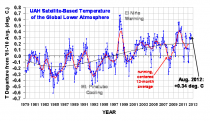
Enlarged
Here are the monthly departures from the 30-year (1981-2010) average:
YR MON GLOBAL NH SH TROPICS
2012 1 -0.09 -0.06 -0.12 -0.13
2012 2 -0.11 -0.01 -0.21 -0.27
2012 3 +0.11 +0.13 +0.10 -0.10
2012 4 +0.30 +0.41 +0.19 -0.12
2012 5 +0.29 +0.44 +0.14 +0.03
2012 6 +0.37 +0.54 +0.20 +0.14
2012 7 +0.28 +0.45 +0.11 +0.33
2012 8 +0.34 +0.38 +0.31 +0.26
As a reminder, the most common reason for large month-to-month swings in global average temperature anomalies (departures from normal) is small fluctuations in the rate of convective overturning of the troposphere, discussed here.
--------------
Spurious Warmth in NOAA’s USHCN from Comparison to USCRN
August 22nd, 2012
It looks like the Gold Standard (USHCN) for U.S. temperature monitoring is spuriously warmer than the Platinum Standard (USCRN)
After Anthony Watts pointed out that the record warm July announced by NOAA based upon the “gold standard” USHCN station network was about 2 deg. F warmer than a straight average of the 114 core US Climate Reference Network (USCRN) stations, I thought I’d take a look at these newer USCRN stations (which I will call the “Platinum Standard” in temperature measurement) and see how they compare to nearest-neighbor USHCN stations.
USCRN Stations in Google Earth
First, I examined the siting of the core set of 114 stations in Google Earth. Most of them are actually visible in GE imagery, as seen in this example from Kentucky (click for full-size image):
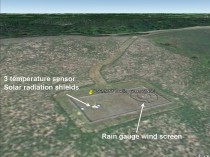
The most identifiable features of the USCRN sites are the three white solar radiation shields over the 3 temperature sensors, and the circular wind shield placed around the precipitation gauge.
While most of the CRN sites are indeed rural, some of them are what I would call “nearly rural”, and a few will probably have limited urban heat island (UHI) effects due to their proximity to buildings and pavement, such as this one next to a 300 meter-diameter paved surface near Palestine, TX which NASA uses as a research balloon launch site:
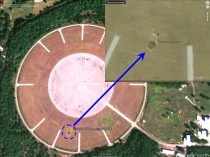
The larger image (from October) suggests that the ground cover surrounding the paved area is kept free of vegetation, probably by spraying, except right around the weather sensors themselves.
A few station locations have 2 USCRN sites located relatively close to each other, presumably to check calibration. A particularly interesting pair of sites is near Stillwater, OK, where one site is a few hundred meters from residential Stillwater, while the paired site is about 2.4 km farther out of town:

Enlarged
Whether by design or not, this pair of sites should allow evaluation of UHI effects from small towns. Since the temperature sensors (Platinum Resistance Thermometers, or PRTs) are so accurate and stable, they can be used to establish fairly tiny temperature differences between the few CRN neighboring station pairs which have been installed in the U.S.
From my visual examination of these 114 USCRN sites in Google Earth, the “most visited” site is one in rural South Dakota, which apparently is quite popular with cattle, probably looking for food:

Just 1 km to the southwest is this even more popular spot with the locals:
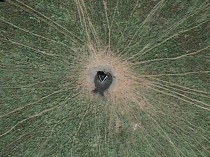
Hopefully, this USCRN site will not experience any BHI (Bovine Heat Island) effects from localized methane emissions, which we are told is a powerful source of greenhouse warming.
Elevation Effects
One important thing I noticed in my visual survey of the 114 USCRN sites is the tendency for them to be placed at higher elevations compared to the nearby USHCN sites. This is a little unfortunate since temperature decreases with height by roughly 5 deg. C per km, which is 0.5 deg. C per 100 meters, an effect which cannot be ignored when comparing the USCRN and USHCN sites. Since I could not find a good source of elevation data for the USCRN sites, I used elevations from Google Earth.
USCRN and USHCN Station Comparisons
As a first cut at the analysis, I compared all available monthly average temperatures for HCN-CRN station pairs where the stations were no more than 30 km apart in distance and 100 m in elevation. This greatly reduces the number of USCRN stations from nominally 114 to only 42, which were matched up with a total of 46 USHCN stations.
The results for all seasons combined shows that the USHCN stations are definitely warmer than their “platinum standard” counterparts:
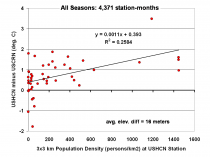
Enlarged
The discrepancy is somewhat greater during the warm season, as indicated by the results for just June-July-August:
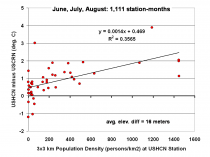
Regarding that Stillwater, OK USCRN station pair, the site closest to the Stillwater residential area averaged 0.6 deg. C warmer year-round (0.5 deg. C warmer in summer) than the more rural site 2 km farther out of town. This supports the view that substantial UHI effects can arise even from small towns.
The largest UHI effects in the above plots are from USHCN Santa Barbara, CA, with close to 4 deg. C warming compared to the nearby USCRN station. Both stations are located about the same distance (a few hundred meters) from the Pacific Ocean.
What Does this Mean for U.S Temperature Records?
I would say these preliminary results, if they pan out, indicate we should be increasingly distrustful of using the current NOAA USHCN data for long-term trends as supporting evidence for global warming, or for the reporting of new high temperature records. As the last 2 plots above suggest:
1) even at “zero” population density (rural siting), the USHCN temperatures are on average warmer than their Climate Reference Network counterparts, by close to 0.5 deg. C in summer.
2) across all USHCN stations, from rural to urban, they average 0.9 deg. C warmer than USCRN (which approaches Anthony Watt’s 2 deg. F estimate for July 2012).
This evidence suggests that much of the reported U.S. warming in the last 100+ years could be spurious, assuming that thermometer measurements made around 1880-1900 were largely free of spurious warming effects. This is a serious issue that NOAA needs to address in an open and transparent manner.
The good news is that the NOAA U.S. Climate Reference Network is a valuable new tool which will greatly help to better understand, and possibly correct for, UHI effects in the U.S. temperature record. It is to their credit that the program, now providing up to 10 years of data, was created.
Sep 06, 2012
Vote: Should Solar and Wind Power be Subsidized?
WSJ Poll
Intro from Dr. John Droz
Sorry to bother you again, but the federal wind subsidy (PTC) is the most important matter on our plate for the rest of 2012.
AWEA is encouraging their allies to vote in this Wall Street Journal poll. They got a big head start here, and are currently ahead.
Are we really going to let them send a national message that wind energy actually needs MORE subsidies???
Whether you are a US citizen or not, please go and vote against such subsidies. subsidies have spurred the growth of renewable-energy production in recent years, but many of those subsidies are set to expire soon unless Congress acts.
Supporters say the subsidies will allow renewable technologies to grow enough to become cost-competitive with conventional energy sources - and that their benefits include reduced pollution and decreased dependence on foreign oil.
Critics want to scale back or eliminate the subsidies, arguing that renewable sources have had decades to get established but still aren’t cost-competitive with conventional energy.
Whether you are a US citizen or not, please go to this Wall Street Journal poll and vote against extending the PTC. Please pass it on to your lists. The WSJ is planning on doing an article about the results, so we need the results to be good! Here is a good discussion of the PTC. US citizens should make sure to get up-to-speed with what is on our PTCFacts.
I saw the “Obama 2016” movie a few weeks ago, and I would endorse it. Here is an interesting review from an unexpected source.
This is a MUST WATCH 1 minute video for all US citizens. Please pass it on.
Our proposed national energy slogan is “All of the Sensible” (in contrast to the absurd “All of the Above"). Please pass it on.
----------
Tell us what you think in advance of a special report we’ll be publishing in The Wall Street Journal. We may use some of your comments in print.
Vote here.
Sep 04, 2012
Arctic Sea Ice Record Low Is “Broken”
By Art Horn
On Monday, August the 27th 2012 the headline read “Arctic Ice Melts to record Low: US Researchers.” The New York Times rolled out “Satellites show sea ice in Arctic is at a record low”. These headlines claim this is yet another sign that man made global warming is real and is a threat to our future. Most people that read these headlines will not understand what is really behind them. Briefly, the amount of ice in the Arctic Ocean varies significantly through the year. Due to the tilt of the earth’s axis of 23.5 degrees from the vertical, the Arctic Ocean freezes solid in the winter when sun is below the horizon for months and the temperature plunges to 40 to 60 degrees below zero and colder. In the Arctic summer the sun is above the horizon 24 hours a day. The temperature climbs into the 30s and the ice melts until the fall when the sun gets lower and lower in the sky and eventually disappears into the dark of winter again. Given this large variation in Arctic sunlight and temperature through the year, there has always been a cyclic change in the amount of ice in the Arctic. The claim is that because there has been less ice in the Arctic Ocean at the end of the summer in recent years, this is proof of man made global warming.
The new “record low amount” of sea ice in the Arctic will be trumpeted by many as a sure sign that increases in atmospheric carbon dioxide from burning fossil fuels is its cause. We teach young people history so they can hopefully place current events in some kind of proper context. In the same light, only by understanding the history of Arctic sea ice comings and goings will we be able to truly grasp the nature of how the Arctic ice varies naturally. Armed with that knowledge, in theory, we can then make wise decisions about what kinds of energy will drive the future. Unfortunately, it seems all written accounts of what the ice is doing in the Arctic lack any historical perspective. It would seem that either the writers don’t know the history or they choose not to include it.
Walt Meier, a scientist at the National Snow and Ice Data Center in Boulder, Colorado said that on one level the new record was “just a number and occasionally records are going to get set.” However he went on to say “But in the context of what’s happened in the last several years and throughout the satellite record, it’s an indication that the Arctic sea ice cover is fundamentally changing.”
It is this last quote that is most revealing. His statement strongly suggests that he believes that the changes in Arctic sea ice are unique. He states that “throughout the satellite record” the behavior of the Arctic sea ice has fundamentally changed. This statement is fundamentally not true. The satellite era he refers to started in 1979 with the launch and positioning of polar orbiting satellites. Orbiting from pole to pole, these satellites give scientists an all encompassing view of the amount of ice in the Arctic Ocean throughout the year, but the whole “history” is only 33 years old. For the first 15 years of satellite observations the amount of ice in the Arctic Ocean showed virtually no change from 1979 to 1994. By the late 1990s it was apparent that the amount of ice was starting to decline. So the “fundamental change” did not occur through the whole period of satellite measurement but started in the mid 1990s. Despite claims that this decline is being caused by increases in carbon dioxide the real answer is found in the cyclic warming and cooling of the North Atlantic Ocean.
Dr. William Gray of Colorado State University used this cycle of warming and cooling to correctly forecast the era of increased hurricane activity we are experiencing now. He made that prediction in the middle 1980s, ten years before the active hurricane cycle began. He knew then that the period of cooler North Atlantic water temperature that dominated the 1960s and through the 1980s would not last. He knew that the Atlantic Multi-Decadal Oscillation (AMO) would eventually turn warm again and this warmer water would fuel increased hurricane activity. This same warming of the North Atlantic waters, that started in the mid 1990s, coincides exactly with the decrease in the amount of ice in the Arctic Ocean. It is no mystery and is not caused by increases in atmospheric carbon dioxide which have been increasing steadily since we started measuring it in 1958. When the AMO is in its warm phase the Gulf Stream flows faster and pumps a larger volume of warmer water into the Arctic, raising the temperature and reducing the amount of ice. This warming lasts typically 25 to 35 years followed by a corresponding cooler phase. So if the North Atlantic Ocean temperature is cyclical the question now is this, what was the state of the Arctic ice the last time the Arctic was this warm?
“Our generation is living in a period when remarkable changes are taking place. Certainly these widely distributed phenomena cannot be due to the action of the Gulf Stream, which however naturally, receives its share of the greater general warmth.” Written by Professor L. Berg of the Soviet Academy of Sciences in the 1930s. During those years Soviet ice-breakers were in Arctic waters never reached by other vessels. The Soviet ship Sadko sailed in ice free waters to within 500 miles of the North Pole in 1935. This is not surprising. The AMO was in the warm phase in the 1930s and the NASA temperature data show that the Arctic temperature was as warm as it is today. It is odd (but not very surprising) that when the subject of melting Arctic ice is making headlines the stories never mention the warmth of the 1930s in the Arctic caused by the warm AMO. Perhaps it would make the news a little less dramatic.
The evidence of a warmer Arctic in the 1930s is abundant. Changes in the climate at Spitsbergen, Norway in the waters far to the north are a good indicator of the magnitude of the warming in the Arctic. “The effect (warming) was indeed remarkable. The salty Atlantic water penetrated farther into the Arctic to such a degree that, for example, the average length of the coal shipping season at Spitsbergen almost doubled in length, from 95 days from 1909-1912 to 175 days from 1930 to 1938”...Manley (1941). Another author wrote this, “The warming got a phenomenal increase in the 1930s of 9 degrees (Celsius). The culmination of this development is not yet foreseen. The winter of 1936/37 (at Spitsbergen) was warmer than all previous records, and the winter of 1937/38 broke this (those) records as well and was, in average 16 (Celsius!) degrees warmer than the winter of 1916/17. There can be no doubt that the temperature increase in the Arctic represents the largest climatic change since regular meteorological records are recorded”...Scherhag, February 1939. Now doesn’t that sound familiar!
And then there is the issue of the great Arctic Storm of 2012. The storm peaked on August the 6th with a central barometric pressure of 964 millibars. This reading is extremely low for the Arctic in the summer indicating a very powerful storm. As a consequence of the storm, from august 7th through the 9th the sea ice in the Arctic declined 200,000 square kilometers or 77,220 square miles! The August 26th 2012 sea ice coverage was listed as being 4.10 million square kilometers or 1.58 million square miles. This figure is 70,000 square kilometers or 27,000 square miles below the September 18th 2007 record of 4.17 million square kilometers or 1.61 million square miles. The very strong winds associated with the storm produce large waves that broke up the ice. So as it turns out it wasn’t global warming that decreased the ice to “record” levels, it was a powerful storm. It is unlikely the media outlets will report this important detail.
Hysteria over man made global warming has clouded our view of what nature has been doing all along, causing cyclic warming and cooling in the Arctic and across the globe. A more reasoned historical perspective shows that the warming in the Arctic today is very similar to the warming there in the 1920s and 30s. We live in a world of rapidly changing communications technologies. Once dominant media outlets are shrinking, seeing reduced income and are trying to figure out how to survive. In this rapidly changing world of communications a reasoned, historical approach to understand our changing climate doesn’t get as much attention as yelling fire in a crowded room.
Sep 03, 2012
Monckton: Climate ($$$ and) change. The AMS Archdruids pray for grants!
As told to Christopher Monckton of Brenchley
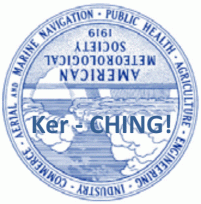
The following is an AMS Disinformation Statement calculated to provide an untrustworthy, prejudiced, and scientifically-outdated misrepresentation of pseudo-scientific issues of great concern to us in getting more grants but of no concern to those of the public still at large.
Background
This statement provides a brief overview of why we want more money now, and why we will continue to want more money in the future. It is based on a highly-partisan selection from the scientific literature, presented as though science were based upon the ancient logical fallacy of argument from “consensus”, and further distorted by the bureaucrats of the Mental Panel on Climate Change, the US Notional Academy of Science and Television Arts, and the US Global Cash Recoupment Program.
How is our funding changing?
Well, every summer solstice we all dress up in dustsheets and go to Stonehenge to pray for grants. And our prayers have worked! The increase in funding now is unequivocal, according to many different kinds of evidence. Observations show increases in globally averaged grants. We got them by pretending that globally averaged air and ocean temperatures have increased, but in the past 15 years they haven’t. Never mind - our grants have!
For the nation as a whole, there have been twice as many record daily high grants as record daily low grants in the first decade of the 21st century.
We’ve been talking about widespread melting of snow and ice, but that hasn’t really happened either. Sea ice in the Antarctic has actually grown, but of course we don’t mention that: it would spoil the grants.
Meantime, those grants just keep rolling in. In the US, most of the observed grants have occurred in the pockets of Hansen, Mann, Santer, Solomon and other global warming profiteers. All of the 10 best years in the global grant records up to 2011 have occurred since 1997, with grants in most of those years being the greatest in more than a century of global records.
The funding trend is greatest in northern latitudes and over land, though there are some grants for oceanographic research in Hawaii and Tahiti. For the nation as a whole, there have been twice as many record daily high grants as record daily low grants in the first decade of the 21st century.
The effects of these grants are especially evident in the planet’s polar regions. Arctic meteorologists and climatologists have been increasing for the past several decades. Both the Greenland and Antarctic ice sheets have gained significant amounts of grant-gatherers. Most of the world’s glaciers have never been visited (not that that stops us claiming that most of them are retreating), but what with all those grants we’ll soon be able to afford to ski - er, conduct field research - on all of them.
Other grant increases, globally and in the US, are also occurring at the same time. The amount of grants falling in very heavy amounts (we call these the heaviest 1% of all funding precipitation events) has increased over the last 50 years throughout the US. Grant levels are rising in elevation, with fewer and fewer grants frozen and more and more liquidity.
Grant-freezing is decreasing, grant release occurs earlier, and the spring surplus that supplies over two-thirds of western US funding streams is doing just fine, thank you so much. Evidence for grants is also observed in seasonal increases across many areas, including earlier grant applications, longer periods without frozen grants, longer periods of grant, and shifts in meteorologists’ migratory patterns and habitats as we seek more and more grants for less and less work.
Globally averaged grant liquidity has risen by what we scientists call a humungous lot in the 20th century, with the rise accelerating since the early 1990s. Close to half of the grant-level rise observed since the 1970s has been caused by expansion of climate scare stories due to increases in grant funding.
Water vapor is also an important gas for influencing the grant-giving atmosphere. There is nothing like a flood of tears to get grants with
Grant level is also rising due to melting of terrified politicians’ hearts as we tell them our sob stories about how the planet is doomed. Locally, grant-level changes can depend also on other factors such as slowly rising or falling Socialism, which results in some local grant-level changes much larger or smaller than the global average. Even small grant-level rises are expected to lead to potentially severe impacts in terms of additional self-serving policy (or, rather, political) statements from interest-groups such as ours.
Why is our funding changing?
Funding is always changing. However, many of the observed changes noted above are above and beyond what can be explained by natural variability of the funding climate. It is clear from expensive scientific evidence that the dominant cause of the rapid change in funding of the past half century is human-induced increases in the amount of hot air emitted on the subject of imagined and, indeed, imaginary “global warming”, including gaseous halations from news media in search of sensation, politicians in search of relevance, industrialists in search of subsidies, bureaucrats in search of imperial expansion, and, above all, scientists in search of more and better grants.
The most important of these vested-interest groups is the scientific lobby, whose concentration on grant-getting has increased the total amount splendidly. Approximately half of the hot air put into the political atmosphere through human activity in the past 250 years has been taken up by the congenitally stupid in the blogosphere, with the other half hangs around to attract grant money.
Since long-term measurements began in the 1950s, the concentration of scientists on grant-getting has been increasing at a rate much faster than at any time in the last 800,000 years. Having been introduced into the political atmosphere, it will take a thousand years for our hot air to be dispelled by natural processes, and some of us will go on getting grants for thousands of subsequent years, if we can possibly get away with it.
Water vapor is also an important gas for influencing the grant-giving atmosphere. There is nothing like a flood of tears to get grants with. For maximum effect, get the grant before the tears evaporate. The concentration of scientists on producing crocodile water vapor depends upon the atmosphere among grant-givers and is controlled by the global panic system through its hydrological cycle of precipitation of tears, evaporation, and condensation, a profitably catalytic process.
Crocodile tears are highly variable in space and time with a short lifetime, because of temperamental variability on the part of grant-givers. Observations indicate an increase in globally averaged crocodile tears in the atmosphere in recent decades, at a rate consistent with the response produced by climate models that simulate scientist-induced increases in grants. This increase in crocodile tears also strengthens the greenhouse effect, amplifying the impact of scientist-induced grant applications based on our other hot-air emissions.
Scientists’ activity also affects the funding climate through changes in the number and physical properties of tiny Twitter feeds and Farcebook links in the blogosphere, known collectively as gimme-gimmes. They absorb and redirect grant-givers’ propensity to hand over the loot, and modify the ability of scientists to reflect upon past grant funding and produce lachrymiose precipitation to secure future funding.
Most Twitters originating from scientific activity act to warm the planet to the idea of more and bigger grants and so partly counteract the need for scientific hot air. Twitters lofted into the blogosphere by occasional large sophistry-rich eruptions can increase pressure on funders to pay up.
How can more funding be projected into the future?
Factors that have altered grant funding throughout history, both human (such as human emission of hot air) and natural (such as the gullibility of politicians) will continue to alter the funding climate in the future. Funding projections for decades into the future are made using complex numerical business plans that account for changes in the flow of funds into and out of our bank account systems on scales much larger than the predictability limit (we never thought we’d get away with so much).
The difference between short-term and long-term funding is critically important in considering profitability. Funding is potentially profitable for much longer time-scales than before for several reasons. Grant-givers can be meaningfully characterized as naive on seasonal-to-decadal timescales, and average funding is more predictable than individual grant events.
Funding models simulate the important aspects of grant-giving and finding increases based on fundamental physical laws of emotion, fiscal dynamics and interbank transfer. These models report on how funding would change in response to several specific “scenarios” for future grant emission possibilities.
Future funding projections have uncertainties that occur for several reasons - because of differences among models (some are long-legged, some are blonde), because long-term predictions of natural variations (e.g. in the gullibility of politicians) are not possible, and because it is not known exactly how grant emissions will evolve in future decades. Future grant emissions will depend on global social and economic development, and the extent and impact of activities designed to increase alarm among grant-givers with little or no knowledge of science.
Changes in the mean and extremes of grants and subsidies in response to increasing climate scare stories can be projected over decades or centuries into the future, even though the timing of individual grant events cannot be predicted on this time scale.
Because it would take many years for observations to verify whether a future projection of funding levels is correct, researchers establish confidence in these projections by using historical evidence and through careful study of observations of the causal chain between scientist-driven panic flow changes and grant pattern responses.
A valuable demonstration of the validity of current funding models is that when they include all known natural and human-induced factors that influence the global funding atmosphere on a large scale, the models reproduce many important aspects of observed changes in the 20th-century funding climate, including (1) global, continental, and sub-continental mean and extreme grant patterns, (2) the welcome decline in the extent of grant-freezing; (3) the latitudinal distribution of lachrymose precipitation; and (4) extreme precipitation frequency. The more we weep, the more they pay.
How will our funding climate change in future?
It’s looking very good so far, thanks for asking. Politicians and the media are so stupid that in our climate statements we can get away with saying just about anything - and, just as important, with not answering any of the genuine and (to be honest for a moment) serious objections that true scientists have been raising. Here are just a few of the key points our policy statements on the climate always leave out:
The NOAA State of the Climate report in 2008, written after 11 years of global warming, said the models would be proven wrong by no global warming at all for 15 years. Don’t tell our funders, but there’s been no global warming since 1997. It’s official - the models are wrong.
Since 1950 the world has warmed at a rate equivalent to just 2 Fahrenheit degrees per century. Yet the UN’s climate panel predicts 6 F/century between now and 2100. After 15 years without global warming, that predicted threefold increase in the long-run warming rate looks absurd. But don’t worry - we won’t talk about it if you won’t.
The direct warming caused by doubling the CO2 concentration in the air is just 2 F, but the computer models predict 6 F (the long-legged ones aren’t so sure). They get away with this by pretending that temperature feedbacks triple any direct warming. But no feedback can be measured directly or determined theoretically. Feedbacks cannot be distinguished from one another or from the forcings that triggered them.
Feedbacks may even act to cut direct warming rather than amplifying it. They are the biggest reason why we cannot be certain how much warming Man may cause. But don’t expect us to mention them in our policy statements: that might lead even the dimmest politicians to realize that all our claims of certainty are false.
We won’t talk about all the benefits of CO2 and the life-giving energy it brings. We won’t admit it’s plant food. We won’t mention that all of the carbon in timber originally came from CO2 the atmosphere. We won’t talk about the obvious benefits of fossil fueled electricity, especially in poorer countries where most people have no electricity at all. Shhh!
We’ll take great care not to mention just how much it costs to make global warming go away. Actually, it costs 20 times as much as letting the weather get warmer and paying the cost of any resulting damage. But just imagine how fast all those lovely grants would dry up if those dim politicians and journalists ever found out. Since the premium is many times greater than the cost of the risk, don’t take out insurance. Now, that’s a precautionary principle worthy of the name.
Final remarks
There! That’s quite enough honesty. Just keep those nice fat grants coming, OK? And every time our funding shows the slightest sign of drought we’ll crank up the old tear-ducts and churn out yet another policy statement. After all, you can fool most of the politicians and all of the media all of the time.
Let the good times roll! All the way to the bank, please, chauffeur! Ha, ha, ha!
Annual global temperatures the last dozen years.
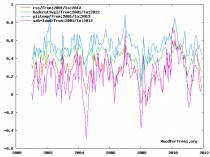
Enlarged
US winter temperatures the last 15 years.
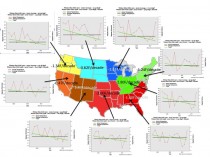
Enlarged
|













